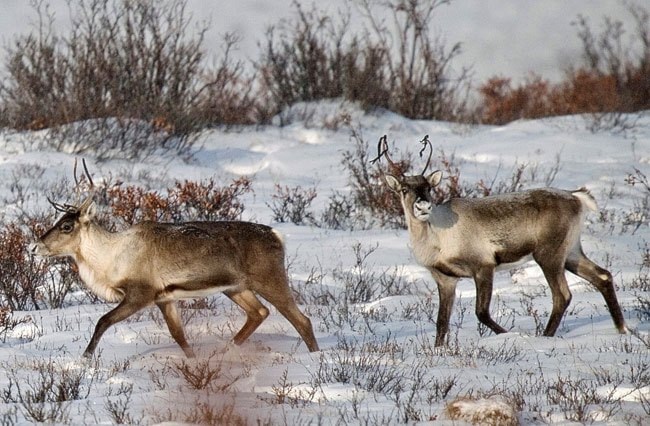Darius Elias, the Liberal MLA for Vuntut Gwitchin, is cheering the territory’s plans to restrict the hunting of Porcupine caribou this autumn.
The Environment Department is proposing a ban on hunting cows from the fragile herd. The ban would apply to all hunters, including those who are First Nation or Inuvialuit.
Such a measure is bound to be controversial—some First Nations are fiercely protective of their hunting rights, and have successfully challenged past attempts by the territory to restrict aboriginal hunting with threats of lawsuits.
The territory also wants to limit licensed hunters to taking one bull, down from two, and to require all hunters to obtain hunting tags and report their kills.
“As far as I’m concerned, it’s about damn time that conservation measures are hopefully being implemented in this territory,” said Elias.
The herd has declined in size for 20 years to a current population that is believed to number fewer than 100,000 animals.
Residents of Old Crow have called for tougher hunting restrictions for more than a decade, said Elias. The proposed regulations, he said, are proof of a “successful lobby effort.”
That’s assuming that Environment Minister Elaine Taylor sticks with her plan and pushes the proposed regulations through.
“Time will tell whether they have the courage to see these measures through. Because there’s going to be resistance,” said Elias.
Opponents of the proposed regulations include the leadership of the Porcupine Caribou Management Board, a body made up of representatives of five First Nations from the Yukon and Northwest Territories, the two territorial governments and the federal government.
They fear that government-imposed restrictions will disrupt hard-earned trust they’ve built up with First Nation and Inuvialuit hunters.
Old hunters still bristle at the mention of game wardens, and remember when seemingly arbitrary rules were imposed upon them. Discontent with paternalistic hunting restrictions was a driving force for the creation of modern land claims.
The board has spent eight years working on a harvest management plan. The plan was released earlier this month and the board hopes to have it signed by the parties involved by mid-August.
But the plan doesn’t go far enough, said Elias.
He’s disappointed with how their “caribou calculator” scheme of restrictions, which ratchet tighter as the herd’s size shrinks, only imposes a ban on hunting cows when the herd’s population drops below 75,000.
“I’d also like to see check-stations at both ends of the Dempster, at the Northwest Territories border and at the Dempster cut-off, with mandatory check-in for all hunters,” said Elias.
“I’d like to see the 500-metre corridor and the letting-the-leaders-pass regulations put back in place on the Dempster for the caribou,” he said.
Those regulations were abandoned several years ago by the territory for fear of legal challenge by First Nations.
“I’d like to see more hunter-education programs. And I’d like to see no hunt of Porcupine (caribou) between October 10 and November 10, during the rut.”
Elias is also disappointed that the management plan lacks any requirement for hunters to report their kills. Such reporting is merely recommended.
It’s estimated that hunters take 4,000 Porcupine caribou each year, but no accurate hunting records exist.
The herd’s current population count also remains unclear. The last photo-census was conducted in 2001. Efforts since then have been hampered by poor weather.
It’s believed that more than half of the total annual take consists of cows, said Elias.
If true, that’s bad news for the herd.
Every cow killed is equal to losing 23 caribou over 10 years, because not only is the cow lost, but so are its offspring, and the offspring of its descendants.
If hunting continues unchecked, the herd’s numbers are expected to go into steep decline so that, in less than 15 years, there will be fewer than 20,000 caribou left.
If the hunt is cut by half, the herd would still decline in number, albeit less dramatically.
The only way to stabilize the herd is to stop shooting cows, according to the management board.
The herd has historically cycled through booms and busts. Before modern times, a population crash of the herd would have also triggered a crash in the number of hunters who depended on the caribou as their food supply.
Today’s technology, from grocery stores to all-terrain vehicles, and the Dempster Highway that cuts through the herd’s migratory path, have changed this dynamic. Hunting pressure no longer naturally eases as the caribou population drops.
The reasons for the herd’s decline remains unclear, although over-hunting is suspected to be a big cause. Climate change may be another culprit.
“If we’re ever at a point of no return with the population of the Porcupine caribou herd, it’s going to be because we didn’t act in time, and control what we could control. That’s the actions of ourselves,” said Elias.
“Fifty years from now, I want to get on my feet and speak with pride about what we did to conserve this herd during our time. I don’t want to be ashamed, and look my great-grandchildren in the eyes, and say, ‘We didn’t have the courage to do the things that needed to be done.’”
“The time for talking is over. I’ve said this time and time again.”
Contact John Thompson at
johnt@yukon-news.com.
